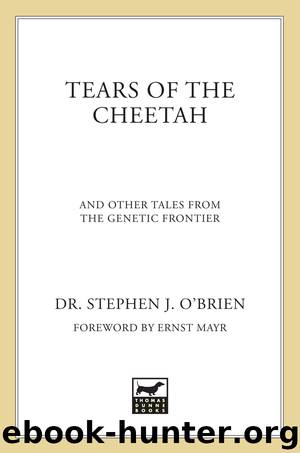Tears of the Cheetah by Stephen J. O'Brien

Author:Stephen J. O'Brien
Language: eng
Format: epub, mobi
ISBN: 9781250102317
Publisher: St. Martin's Press
Ten
The Way We Were
Nothing in biology makes sense except in light of evolution.
—THEODOSIUS DOBZHANSKY
The Old Testament, as interpreted by the esteemed seventeenth-century archbishop James Ussher, tells us that the earth is 6,005 years old and that Noah boarded his ark 4,348 years ago. As I grew up in the Christian religion of my parents and theirs, I was taught to accept on faith these and other biblical truths. Although my questions would be answered sincerely, there was peril in being too querulous, in not being convinced of the accuracy of the tenets of theological history. The danger was to be branded a heretic, an apostate, a pariah.
Scientists who study geology and the planetary history estimate the earth as a bit older, on the order of 4.5 billion years. Life started, they discern, not on a Monday of the Creator’s busy week, but more slowly over millennia of chemical reactions in an oxygenated primordial soup that slowly oozed into a murky swamp of the earliest self-reproducing microorganisms. These primitive life forms were built upon a chemical code that specified a living blueprint, a DNA double helix of single nucleotide letters or base pairs with four basic varieties: adenosine-A, cytosine-C, thiamine-T, and guanosine-G. Two linear strings of millions of nucleotide letters on each side of a twisted ladderlike structure were attached by weak chemical bonds that ensured complementarity. The T nucleotide would always bind to A, and the G would invariably be matched by a C. (I used to remember this pairing as the initials of Thomas Aquinas and Geoffrey Chaucer.) So a GTAGTA stretch on one strand of the helix was matched with a CATCAT counterpart on the other. This A-T/G-C letter complementarity is the basis for DNA replication and of the primitive organisms’ reproduction. That very simple chemical structure forms the platform upon which life on earth stands today.
The first signs of life appear in geological fossil remains that were deposited around 600 million years ago. Six hundred million years ago—how long is that, really? The trouble with these vast age estimates is that most people cannot imagine the difference between, say, 100,000 years, 1 million years, 100 million years, or 1 billion years. They all seem like a very, very, very long time ago! Yet trying to grasp what they mean can brightly illuminate the timing of biological species’ comings and goings, including the how and why of our own human origins.
Fifty years ago a science journalist, James C. Rettie, proposed a graphic image of geological time in a popular magazine that was similar to today’s Reader’s Digest called Coronet. Rettie imagined a sophisticated space traveler from another galaxy who aimed a camera with a wide-angle super-telephoto lens at the earth before life began, some 750 million years ago. The alien photographer set the camera on time-lapse, taking a single image each year until modern times. Projected at the normal speed of twenty-four frames per second, the resulting movie, playing twenty-four hours a day, seven days a week, would take a year to view.
Download
This site does not store any files on its server. We only index and link to content provided by other sites. Please contact the content providers to delete copyright contents if any and email us, we'll remove relevant links or contents immediately.
| Anatomy | Animals |
| Bacteriology | Biochemistry |
| Bioelectricity | Bioinformatics |
| Biology | Biophysics |
| Biotechnology | Botany |
| Ecology | Genetics |
| Paleontology | Plants |
| Taxonomic Classification | Zoology |
Sapiens: A Brief History of Humankind by Yuval Noah Harari(14322)
The Tidewater Tales by John Barth(12627)
Mastermind: How to Think Like Sherlock Holmes by Maria Konnikova(7280)
Do No Harm Stories of Life, Death and Brain Surgery by Henry Marsh(6908)
The Thirst by Nesbo Jo(6882)
Why We Sleep: Unlocking the Power of Sleep and Dreams by Matthew Walker(6659)
Life 3.0: Being Human in the Age of Artificial Intelligence by Tegmark Max(5518)
Sapiens by Yuval Noah Harari(5325)
The Longevity Diet by Valter Longo(5043)
The Body: A Guide for Occupants by Bill Bryson(5031)
The Rules Do Not Apply by Ariel Levy(4911)
The Immortal Life of Henrietta Lacks by Rebecca Skloot(4552)
Animal Frequency by Melissa Alvarez(4430)
Why We Sleep by Matthew Walker(4395)
The Hacking of the American Mind by Robert H. Lustig(4341)
Yoga Anatomy by Kaminoff Leslie(4334)
All Creatures Great and Small by James Herriot(4272)
Double Down (Diary of a Wimpy Kid Book 11) by Jeff Kinney(4243)
Embedded Programming with Modern C++ Cookbook by Igor Viarheichyk(4143)
